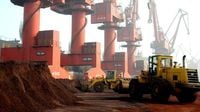Amid the ongoing U.S.–China trade war, Chinese authorities have reportedly imposed export controls on rare earth elements (REEs) and magnets that are essential in a variety of manufacturing processes, from semiconductor fabrication to defense equipment. This latest move has intensified the trade tensions between the two nations, as the restrictions apply to any Chinese refinery capable of exporting refined rare earths beyond its borders.
Rare earth elements encompass a series of seventeen substances found in the earth’s crust. Contrary to what the name suggests, these elements are not particularly rare in nature; the challenge lies in isolating them chemically for industrial use. Heavy and light rare earths can be found in several countries, including India, China, Myanmar, Japan, Australia, and North Korea. The current export curbs specifically target dysprosium, gadolinium, lutetium, samarium, scandium, terbium, and yttrium—seven of the seventeen classified REEs.
Dysprosium is known for its magnetic susceptibility, making it ideal for applications in hard disks and car motors. Gadolinium finds its use in nuclear reactors for shielding and in certain medical technologies, while lutetium and its compounds are utilized in PET scanners and petroleum refineries. Samarium is critical for the production of powerful magnets used in personal electronics, and scandium-aluminium alloys are employed in fighter aircraft. Terbium is used in lighting for personal electronics, and yttrium plays a role in cancer treatments and superconductors.
While rare earths are available in multiple countries, China has dominated the refining process, especially for heavy REEs. A heavy rare earth facility that opened in Vietnam is currently non-operational due to a tax dispute, which further consolidates China's position in the global supply chain for these critical materials. This gives Beijing substantial leverage over supply chains that are crucial for various industries worldwide.
Although the export restrictions do not constitute a full ban, they may disrupt supplies to other countries for several weeks as refiners navigate the permit application process. This uncertainty raises concerns about the impact on global supply chains, particularly for nations reliant on Chinese exports.
In India, the immediate effects of China's REE export restrictions may not be felt right away. The Indian government has been proactive in bolstering domestic production of semiconductors and defense equipment, but the more advanced stages of manufacturing still occur abroad, predominantly in China and Japan. Japan, in particular, has already taken measures to shield itself from potential REE supply shocks by amassing a stockpile that could last several months.
India recognizes the significance of REE production, estimating that it holds around 6% of the world's total deposits. However, environmental concerns have hindered the country's mining and refining capabilities, which remain virtually non-existent. Currently, India does possess some light REE extraction capabilities through the state-owned Indian Rare Earths Ltd, which includes the extraction of monazite from beach sand in Kerala, a mineral not affected by China's export restrictions.
According to the Ministry of Mines, India imported a limited quantity of REEs, totaling 2,270 tonnes in the 2023–24 fiscal year. This underscores the country's reliance on both domestic production and imports to meet its needs. The government has initiated a strategic framework known as the National Critical Mineral Mission (NCMM) aimed at securing the critical mineral supply chain by enhancing domestic production and diversifying foreign supply sources.
As part of the NCMM, the Indian government has committed to facilitating or engaging in 1,200 exploration projects, awarding exploratory licenses to encourage private exploration, and auctioning more critical mineral blocks. The mission also aims to streamline regulatory approvals for critical mineral exploration and extraction.
In a recent presentation, the Ministry of Mines highlighted that China’s restrictions on specific critical minerals, coupled with the ongoing Russia–Ukraine War, underscore the fragility of the global critical mineral supply chain and the pressing need for diversification. This recognition comes at a time when China's increasing reliance on foreign demand poses a critical weakness, which was somewhat obscured by the country's unexpectedly strong economic growth in the March quarter.
Indeed, net exports accounted for more than 40% of the 5.4% increase in China's GDP during this period—the largest contribution from net exports in over a decade. As trade tensions escalate, the risk of a more severe economic shock looms large for China, raising questions about the sustainability of its growth trajectory.
As countries around the world grapple with the implications of these export restrictions and the broader trade war, the need for strategic planning and diversification in critical mineral supply chains has never been more apparent. The developments in the rare earth sector not only highlight the intricate web of global trade relationships but also the growing importance of self-sufficiency in essential materials.
In light of these recent events, it remains to be seen how countries like India will adapt to the shifting landscape of global supply chains and whether they can effectively leverage their own resources to mitigate the risks posed by external market fluctuations.





